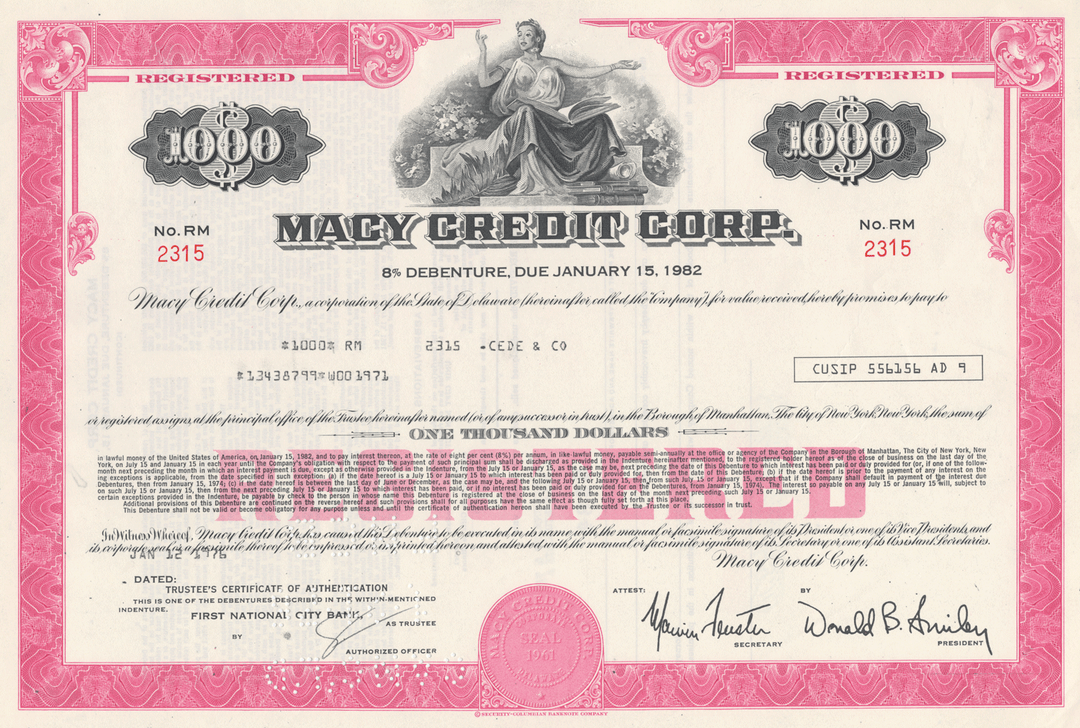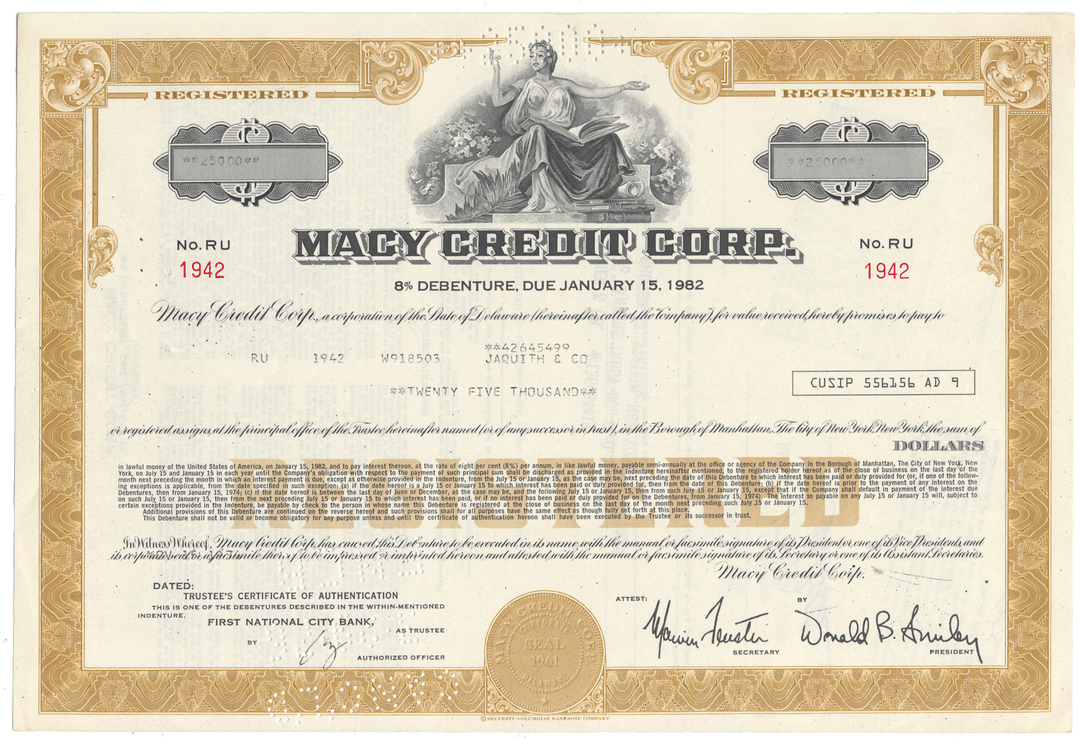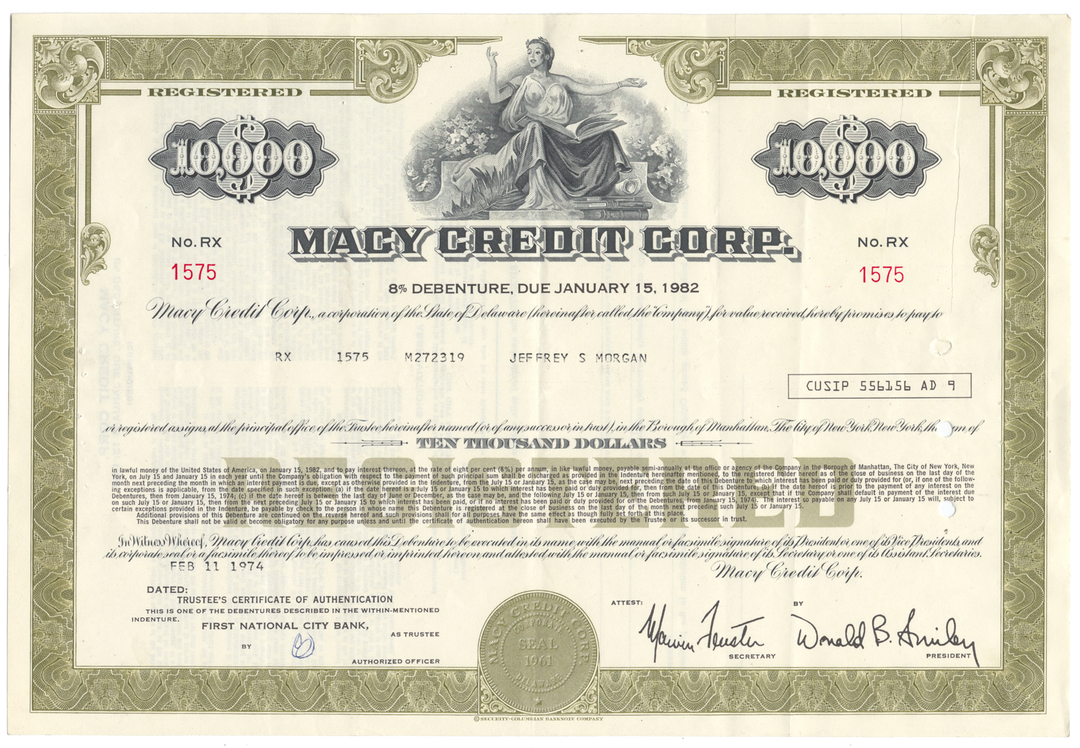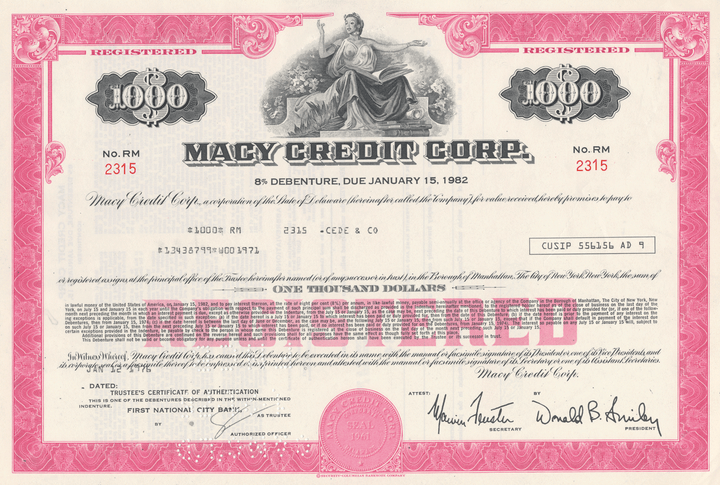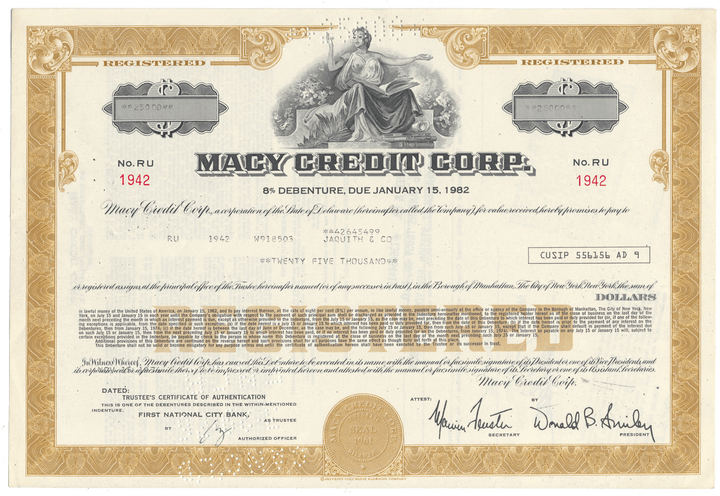Macy Credit Corp.
- Guaranteed authentic document
- Orders over $75 ship FREE to U. S. addresses
Product Details
Company
Macy Credit Corp.
Certificate Type
Debenture Bond
Date Issued
1970's
Canceled
Yes
Printer
Security-Columbian Bank Note Company
Signatures
Machine printed
Approximate Size
12" (w) x 8" (h)
Images
Representative of the piece you will receive
Guaranteed Authentic
Yes
Additional Details
NA
Historical Context

Rowland Hussey Macy opened four retail dry goods stores between 1843 and 1855. One of them was the original Macy's store in downtown Haverhill, Massachusetts; it opened in 1851 to serve the mill industry employees of the area. They all failed, but Macy learned from his mistakes. Macy moved to New York City in 1858, to establish a new store named "R. H. Macy & Co." on Sixth Avenue between 13th and 14th Streets. The location was far north of where other dry goods stores were at the time. On the company's first day of business on October 28, 1858, sales totaled $11.08, equal to $326.82 today. From the beginning, the Macy's logo included a star, which comes from a tattoo that Macy got as a teenager when he worked on a Nantucket whaling ship, the Emily Morgan.
As the business grew, Macy's expanded into neighboring buildings, opening more and more departments. The store used publicity devices such as a store Santa Claus, themed exhibits, and illuminated window displays to draw in customers. It also offered a money-back guarantee, although it accepted only cash into the 1950s. The store also produced its in-house made-to-measure clothing for both men and women, assembled in an on-site factory.
In 1875, Macy took on two partners, Robert M. Valentine, a nephew; and Abiel T. La Forge of Wisconsin, who was the husband of a cousin. Macy died in 1877 from inflammatory kidney disease (then known as Bright's disease). La Forge died the following year, and Valentine died in 1879. Ownership of the company remained in the Macy family until 1895, when the Straus brothers acquired the company (now called "R. H. Macy & Co."). Isidor Straus and his brother Nathan Straus had previously held a license to sell china and other goods in the Macy's store.
In 1902, the flagship store moved uptown to Herald Square at 34th Street and Broadway, so far north of the other main dry goods emporia that it had to offer a steam wagonette to transport customers from 14th Street to 34th Street. Although the Herald Square store initially consisted of just one building, it expanded through new construction, eventually occupying almost the entire block bounded by Seventh Avenue on the west, Broadway on the east, 34th Street on the south and 35th Street on the north, with the exception of a small pre-existing building on the corner of 35th Street and Seventh Avenue and another on the corner of 34th Street and Broadway. This latter 5-story building was purchased by Robert H. Smith in 1900 for $375,000 with the idea of getting in the way of Macy's becoming the largest store in the world: it is largely supposed that Smith, who was a neighbor of the Macy's store on 14th Street, was acting on behalf of Siegel-Cooper, which had built what they thought was the world's largest store on Sixth Avenue in 1896. Macy's ignored the tactic, and simply built around the building, which now carries Macy's "shopping bag" sign by lease arrangement. In 1912, Isidor Straus died in the sinking of the Titanic at the age of 67 with his wife, Ida.
The original Broadway store was designed by architects De Lemos & Cordes, was built in 1901–02 by the Fuller Company and has a Palladian facade, but has been updated in many details. There were further additions to the west in 1924 and 1928, and the Seventh Avenue building in 1931, all designed by architect Robert D. Kohn, the newer buildings were increasingly Art Deco in style. In 2012, Macy's began the first full renovation of the iconic Herald Square flagship store at a reported cost of $400 million. Studio V Architecture, a New York-based firm, was the overall Master Plan architect of the project. Studio V's design raised controversy over the nature of contemporary design and authentic restoration.
The building was added to the National Register of Historic Places as a National Historic Landmark in 1978.
In the 1960s, Macy's built a store on Queens Boulevard in Elmhurst, in the New York City borough of Queens. This resulted in a round department store on 90 percent of the lot, with a small privately owned house on the corner. Macy's no longer fully occupies this building, which now contains the Queens Place Mall, with Macy's Furniture Gallery as a tenant; instead it moved its full outlet to the nearby Queens Center.
More distant acquisitions included Lasalle & Koch (Toledo, 1924), Davison-Paxon-Stokes (Atlanta, 1929), L. Bamberger & Co. (Newark, 1929), O'Connor Moffat & Company (San Francisco, 1945) and John Taylor Dry Goods Co. (Kansas City, 1947). O'Connor Moffat was renamed Macy's San Francisco in 1947, later becoming Macy's California, and John Taylor was renamed Macy's Missouri-Kansas in 1949. Stores in Toledo retained the Lasalle's name until 1981, joining the Missouri-Kansas stores to become Macy's Midwest. The Toledo stores were sold to Elder-Beerman in 1986.
Macy's New York began opening stores outside of its historic New York City–Long Island trade area in 1983 with a location at Aventura Mall in Aventura, Florida (a suburb of Miami), followed by several locations in Plantation, Florida (now relocated from the Fashion Mall to the Broward Mall since the Burdine's acquisition), Houston, New Orleans, and Dallas. Davison's in Atlanta was renamed Macy's Atlanta in early 1985 with the consolidation of an early incarnation of Macy's Midwest (former Taylor and Lasalle's stores in Kansas City and Toledo, respectively), but late in 1985, Macy's sold the former Midwest locations. Bamberger's, which had aggressively expanded throughout New Jersey, into the Greater Philadelphia Metropolitan area in the 1960s and 1970s as well as into Nanuet, New York (southern Rockland County), and into the Baltimore metropolitan area in the early 1980s, was renamed Macy's New Jersey in 1986.
In 1986 Edward Finkelstein, Chairman & CEO of R. H. Macy & Co., Inc., led a leveraged buy-out of the company and subsequently engaged in a takeover battle for Federated Department Stores, Inc., in 1988 that he lost to Canada's Campeau Corporation. As part of its settlement with Campeau, Macy's purchased Federated's California-based, fashion-oriented Bullock's and its high-end Bullocks Wilshire and I. Magnin divisions. It followed with a reorganization of its divisions into Macy's Northeast (former Macy's New York and Macy's New Jersey), Macy's South/Bullock's (Macy's Atlanta stores plus Macy's New York's operations in Texas, Florida and Louisiana), and Macy's California, the latter including a semi-autonomous I. Magnin/Bullocks Wilshire organization. The Bullocks Wilshire stores were renamed I. Magnin in 1989. Subsequently, R. H. Macy & Co., Inc., filed for Chapter 11 bankruptcy protection on January 27, 1992, after which point its banks brought in a new management team, which shut several underperforming stores, jettisoned two-thirds of the luxury I. Magnin chain, and reduced Macy's to two divisions, Macy's East and Macy's West.
Macy's East, New York City was a division of Macy's, Inc. It is the operating successor to the original R.H. Macy & Co., Inc. and operates the Macy's department stores in the northeast U.S. and Puerto Rico. Over the years it has been known as Macy's New York and Macy's Northeast. On February 1, 2006, Macy's East assumed operating control over the Filene's, Strawbridge's, many of the Kaufmann's stores in upstate New York and the Hecht's stores in Pennsylvania, Maryland, Washington, DC and northern Virginia. These locations assumed the Macy's moniker officially on September 9, 2006. In 2008 Macy's East took over the small Macy's North division.
In May 1993, Macy's announced the planned fall 1994 launch of TV Macy's, the retailer's own home shopping channel, in conjunction with Don Hewitt, Thomas Leahy and Cablevision.
R. H. Macy & Co. merged with Federated Department Stores on December 19, 1994.
Related Collections
Additional Information
Certificates carry no value on any of today's financial indexes and no transfer of ownership is implied. All items offered are collectible in nature only. So, you can frame them, but you can't cash them in!
All of our pieces are original - we do not sell reproductions. If you ever find out that one of our pieces is not authentic, you may return it for a full refund of the purchase price and any associated shipping charges.






